Part Three: Paternoster, Cape Town,
Oudtshoorn, Plettenberg Bay, Port Elizabeth, & Addo
Day
8: Cañon Lodge – Paternoster (800 km/10 hours)
Before
departing, we had a wonderful breakfast at Cañon Lodge to send us off properly.
Giulia and I were traveling down the South African west coast to Paternoster
and Gerhard and family were heading back Johannesburg via Vryburg. We packed
our cars and took the "challenging" (to be diplomatic) road from the
day before (see previous post). As we were cruising over the gravel hills,
bouncing around, it started to drizzle, a rarity in Namibia (for example:
Gerhard lived in Namibia for three years and only saw rain once). I turned my
windshield wipers on, but nothing happened. I turned them off, bounced over a
hill, then tried them again, nothing. I pulled over and got out my microfiber
towel from the trunk (South African: boot). As I drove, I stuck my arm out of
the window and wiped off the oncoming rain. Finally, we made it to the end of
the road, where Gerhard et al. and Giulia and I would go our separate ways.
Before continuing on Gerhard and I popped the hood and looked at the fuse box,
but could not find anything wrong. We said our cold, rainy goodbyes and set off
toward the South African border. Fortunately, it wasn't a "Midwestern
rain" where it's cloudy and rains all day - there were lighter clouds on
the horizon. Throughout the course of driving the ten hours to Paternoster, it
rained for about ten minutes each hour, where I would turn my hazard lights on,
slow down, and wipe incessantly. Before leaving, Gerhard recommended that we
stop in Springbok, the largest town in the north of the Northern Cape to see if
any auto shop is open (it was Saturday). Giulia and I arrived in Springbok, but
we must have gotten off an exit too soon; we arrived to a shantytown with one
petrol station and absolutely no cars on the road. Pulling up to the lone
petrol stop, we were greeted by an attendant, who was rubbing his hands on an
oil rag (like you see in movies, heck, he might have spit into a spittoon, a la
the "American South"). He kindly told us that the city center was the
next exit. We continued on to a petrol station in the booming metropolis
(insert: irony) of Springbok. I asked the attendant for a recommendation of a
garage and he didn't know of any and/or know of any open on Saturday. After
filling up, we drove down the main street, all three traffic lights, and found
no open mechanics. With no other option, Giulia and I stopped to get food at a
grocery store and continued onward. The N7, which runs along the west coast of
South Africa, is one of the most scenic drives I've been on: it begins with
mountains and passes in the north, followed by the rolling wine lands just
north of Cape Town. After ten hours in the car, we arrived in Paternoster, a
small town on the Atlantic Coast. The violent Atlantic crashed against the shore
reverberating throughout the city. We checked into our bed and breakfast,
ordered take away pizza, and crashed.
 |
| Goodbyes! (See: wiping windshield) |
Day
9: Paternoster – Cape Town (150 km/1.5 hours)
The
next morning, we set off for Cape Town … I was eager to get to the city, as I
didn't like driving with broken windshield wipers. Before leaving, I asked the
bed and breakfast owner if rain was predicted in Cape Town, "No" was
his reply. His response kept replaying in my mind as I reached my hand out of
the window and wiped the windshield on our way to Cape Town. We checked into
our bed and breakfast and it started pouring outside, with a thick fog over the
city. The bed and breakfast was lovely; a 5 minute walk to city center and on a
hill overlooking the city (our room had a private balcony). The rain gave us a
chance to catch our breath and take care of laundry/rest. Mid-afternoon the
rain started to slow and we decided to go down to the V&A Waterfront, a
beautiful seafront mall with restaurants, shops, museums, and the marina. We
strolled around the shops; stopped in "Cape Union Mart" an awesome
outdoor store to pick up K-way "jerseys" (sweaters) to be more South
African, had a drink at Mitchells Brewery, one of the only microbreweries in
South Africa, and then went to dinner to celebrate our birthdays (post-hoc).
After a lovely dinner, we had an early night, as I was to wake up early the
next morning (Monday) to take my care to the mechanic.
 |
| Cape Town B+B |
 |
| View from balcony (better with no fog!) |
 |
| V+A Waterfront |
 |
| My future catamaran |
 |
| Birthday Dinner! |
Day
10: Cape Town
The
next morning I set off for Bosch Automotive, a well-known South African chain
of auto mechanics, which on Google Maps said that we were 2 kilometers away
from in our bed and breakfast. I set off and followed my GPS, only to find an
abandon building. I looked up other options in my GPS only to stop at an Avis
Car Rental to ask for advice, which was of little help. All the while, it
started to rain and make the search more difficult. Frustrated, I entered Bosch
into the GPS and went to the next closest location, 6 kilometers out of the
city (with rain/rush hour traffic). Fortunately when I arrived, Bosch said that
they could take care of it today and even taxied me back to the bed and
breakfast. Giulia and I had breakfast and set off, walking around the city
center and then eventually took the "hop on, hop off" bus tour around
the city and surrounding areas (Green Point, Sea Point, Table Mountain). After
the tour I received a call that the car would be ready for pick up in the early
evening. Bosch picked us up and when I got my car with working windshield
wipers, we set off for tea/coffee with Onkel Theo and Tante Magdalena. We had a
wonderful visit with my Great-Uncle and Great-Aunt (my Grandmother's brother),
as I had not seen them since I was last in South Africa in 2010 (Onkel Theo and
I took an incredible 1500km road trip).
 |
| View from B+B |
 |
| Table Mountain hidden behind fog |
 |
| B+B |
 |
| Coffee, tea, and cake at Tante Magdalena's |
Day
11: Cape Town – Betty’s Bay/Kleinmond – Oudtshoorn (450 km/6 hours)
We
set off early the next morning, traveling to Oudtshoorn taking the long route
along the scenic coast. The scenery east of Cape Town, along the coast, is one
of the most breathtaking areas in South Africa (if not the world, seriously).
We stopped in Betty's Bay at the penguin sanctuary, one of the largest natural
colonies of penguins in South Africa (know that the majority of penguins
actually live in warm climates). The sanctuary has a boardwalk out the coast
and it is surrounded by hundreds of penguins/nests. We enjoyed watching them,
they're quite goofy animals. As we got to the end of the boardwalk, a looming
storm was on the horizon, with the wind increasing and temperature dropping. It
turns out that the storm would continue to follow us as we travelled eastward
throughout the rest of the week. After the penguin sanctuary, we continued to
drive along to the coast to Kleinmond, a beautiful coastal town where Onkel
Theo has a house on the ocean. We continued on to Oudtshoorn, driving through
beautiful mountain passes as we entered the "Little Karoo". Exhausted
from the long day(s) we had a nap and went out to dinner, saving our "to
do list" in Oudtshoorn for the next day.
 |
| Driving to Betty's Bay |
 |
| Penguin sanctuary at Betty's Bay |
 |
| Onkel Theo's house at Kleinmond |
 |
| View from the house |
 |
| Oudtshoorn B+B |
Day
12: Oudtshoorn – Plettenberg Bay (150 km/2 hours)
The
next morning, the rain followed us and cast a gloom, wet, and cold over
Oudtshoorn. Determined to follow through with our optimistic "to do
list," we first set off for the Cango Wildlife Ranch, a conservation facility
that doubles as an interactive zoo. The park rescues injured animals and tries
to rehabilitate and release them back into the wild, if not they
"retire" into the zoo. We took a tour throughout the park, seeing the
dwarf hippopotamus, otters, storks, flamingos, lemurs, crocodiles, lions,
cheetahs, leopards, Bengali tigers (not obviously native to South Africa), and
many more. After our tour, we went to the Cheetah Preservation Foundation,
which offers interactions with the cheetahs (they also offer tiger
interactions). Before the trip, when I mentioned to Giulia that the Cango
Wildlife Ranch offered cheetah interactions, she was immediately sold on the
idea (a keen lover of animals). So, we both decided to "interact"
with the cheetahs, choosing the one-year-old cheetahs over the fully-grown
adults. It was an incredible experience. Understandably they are dangerous
animals with specific instincts, however, I/we felt safe the entire time, with
three trainers in the area with us. The cheetahs were social, purred, brushed
up against our legs, licked Giulia's jeans and enjoyed petting (!). After the Cango Wildlife Ranch, it
started to rain and we decided to go to the Cango Caves. The Cango Caves are
well known for their massive caverns and beautiful stalagmites/stalactites. One
of my favorite experiences of the tour is when we were in the largest cavern,
which hosted an orchestra concert that was able to seat 1500 people, and the
tour guide turned off the lights. It really makes you wonder the sanity of the
original explorers of the cave by candlelight. The caves are beautifully lit, producing
interesting shadows and colors. Our final stop before leaving Oudtshoorn was
the Cango Ostrich Farm. Originally, I wanted to go to the Highgate Ostrich
Farm, a famous farm that I went to in 2010 and Gerhard worked at in his young
years. Unfortunately, the farm has been closed for months due to bird flu
affecting ostriches in the area. In any event, we went to the farm, learned
about the ostriches, were able to interact with them, feed, them, sit on the
ostrich (it was too muddy from the rain to ride), and stand on ostrich eggs! From
the Cango Ostrich Farm, we drove to Plettenberg Bay through George and Knysna,
two beautiful coastal cities…an area I really think is beautiful. We checked
into our B+B on the oceanfront and headed into the town for dinner.

 |
| Bats |
 |
| River Hog |
 |
| Not the most attractive bird you'll ever see |
 |
| Walkway over the lion reserve |
 |
| Cango Caves |
 |
| Cango Ostrich Farm |
 |
| Bed and Breakfast in Plettenberg Bay |
Day
13: Plettenberg Bay – Port
Elizabeth (230km/2 hours)
The
next morning we relaxed, feeling the nomad lifestyle catching up with us. After
a nice breakfast on the glass patio at the bed and breakfast, we went for a
cold walk on the beach (even taking off our shoes to dip our feet in the Indian
Ocean). We then set off for Port Elizabeth, traveling along the coast. We
stopped at Bloukrans Bridge, home
of a 216 meter bungy jump underneath the bridge, to watch the
"crazies" who decide to bungy jump. From Bloukrans Bridge, we stopped
at Jeffery's Bay, a "gnarly" surfing town, home of some of the best
waves in South Africa for lunch. After "J-Bay," as the South Africans
call it, we went to Port Elizabeth and spent time driving through the city and
walked along the beach/pier. We then went to Raymond and Sylvia's home, who
were kind enough to host us for the night. They are dear family friends, both
former members of my Great-Grandfather's congregation in the Eastern Cape
(north of King William's Town). They looked after my Great-Grandfather and
Great-Grandmother, who retired in Port Elizabeth. I first met them in 1996 when
they came to Toledo during their trip to the US, visiting my Grandparents. I
fondly remember going on the boat for 4th of July fireworks with them, sitting
and hugging Sylvia the entire time J.
In 2010, Onkel Theo and I went to Port Elizabeth to visit and stay with them as
well. Giulia and I really enjoyed the stay and their warm hospitality. We had a
wonderful dinner, talked/reminisced, and were able to get a good nights rest.
 |
| Plettenberg Bay |
 |
| Bloukrans Bridge |
 |
| Port Elizabeth |
Day
14: Port Elizabeth – Addo (60 km/1 hour)
Before
departing from Port Elizabeth, we went out to breakfast with Raymond and
Sylvia. We were sent off in the rain, which again, continued to follow us
through the Western Cape and Eastern Cape. We drove to the Addo Elephant Park,
a South African National Park that has much more than just elephants. Its an
expansive and beautiful park. We drove around for a few hours seeing: spotted
hyena, jackal, elephant (a pregnant elephant too), buffalo, and zebra. We then
checked into our bed and breakfast, resting before our afternoon safari. Unfortunately,
I forgot to print the confirmation to the safari and looked up the time of the
tour online. We left in time to get to the safari at 4pm (4pm - 10pm, said the
website I looked at). As we were driving toward the safari, I received a call
from the safari asking where we were and wondering why I hadn't responded to
the voicemails that were left for me. Due to the poor cell phone reception at
the bed and breakfast, we didn't hear that the actual start time was 2:30pm!
Fortunately, the safari company was able to organize a staff member to meet us
at the office and drive us to meet up with the rest of the group (and the group
didn't leave until after 3pm). The safari was on a private game reserve - hundreds
of hectares of land near the Addo Elephant Park. The animals are not fed,
rather they roam wildly and live naturally. We met up with group, who had just
seen giraffe and hippopotamus. Bundled for the cold and ready to continue, we
drove through the private game reserve, first finding two white-rhinoceros
resting. The safari guide was very knowledgeable, giving us both insight into
the animal and the poaching problem in South Africa. Interestingly, he said
that they don't cut the horns off of the rhino in the national parks because
they found that it wouldn't deter the poachers from killing the animal.
Poachers track the animals for days in the park and when they find one without
a horn, they still kill it so that they know they are not tracking it anymore
(sad). With the prices of rhino horn more than gold, poachers are finding new
ways to get the horn (helicopter even!).
In any event, we continued driving through the bush, stopping to see
kudu, impala, and wildebeest. As the sun started to set (behind the clouds),
the guide received a call on the radio from one of the other vehicles about a
distressed animal sound. We set off toward the noise, finding a male lion
heading toward the noise as well. Continuing on we found two lionesses holding
onto the neck of a wildebeest. It struggled for a few minutes and then fell
silent. Meanwhile, the male lion came to the wildebeest and proceeded to lick
the dead animal (possibly claiming his territory). After the kill, the male
lion ate first, digging into the stomach of the animal. The lionesses' went to
find their cubs each lioness had three cubs. The pride of lion, one male, two lioness,
and six cubs took their turns on the animal. Confusingly, the animals did not
look hungry (said our guide), and didn't eat much of the animal, rather the
cubs played with the wildebeest. We set off for dinner in the bush,
understanding that we would go back to the kill to see the progress the lions
had made. Dinner was a traditional South African meal - all made over the fire,
delicious! After dinner, we went back to the kill to see that the lions made
little progress, confirming the guides' first observation that they lions
weren't hungry. From the kill, we headed back to the ending the safari.
Overall, it was incredible to see the kill, a rarity not often seen. Although
at times it was disgusting, it is nature in its purest form, and we could not,
not (sorry - double negative) watch it. After the safari we headed back to the
B+B and tried to get a good night's sleep before heading back to Johannesburg
early the next morning.
 |
| Addo Elephant Park |
 |
| Pregnant Elephant |
 |
| On the safari |
 |
| Tea/coffee break at the lodge |
 |
| Giulia manning the searchlight |
 |
| First sighting of lions (male walking to the kill) |
 |
| Lionesses with wildebeest |
Day
15: Addo – Johannesburg (1000km/11 hours)
The
next morning we left early from rainy Addo, a long 1000km trip ahead of us.
During the trip, we had every type of weather imaginable: down-pouring rain,
light rain, snow, and excessive wind. The ride was not the highlight of the
trip, understandably, and I have a new found distain for driving through the
Free State (there's absolutely nothing to look at). We had difficulty finding
food (a grocery store, or something like it), with the nothingness of the
countryside. Luckily, Marlize made a travel bag for us and we had leftover
peanut butter, bread, fruit, and rusks. We arrived at 6pm to Johannesburg,
staying at Gerhard and Marlize's house, rather than driving back to my cold,
dark, and foodless house (how nice of them!). We enjoyed a nice, warm meal
together, had a good rest and started to get back to reality.
 |
| Stylish! |
Closing
If
you made it through these two massive posts, congratulations! I hope that you
enjoyed the in-depth overview of our trip… I felt compelled to write so much
because, well, it was such an incredible and meaningful trip. The experiences
we shared, the things we saw and that we did over our 5200km journey was unforgettable…I
could not have asked for a better trip. A big thanks to Gerhard and Marlize for
organizing the first half of the trip, being wonderful travel-buddies, and for
fun we shared!


















































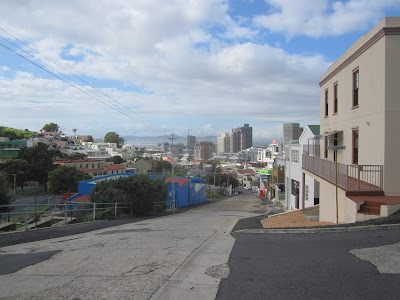








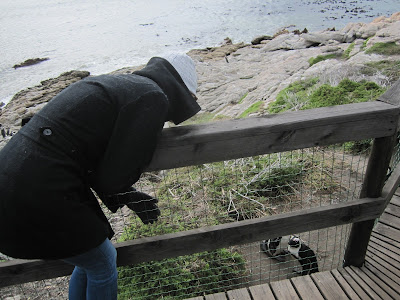
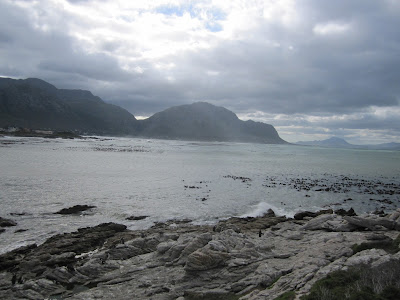























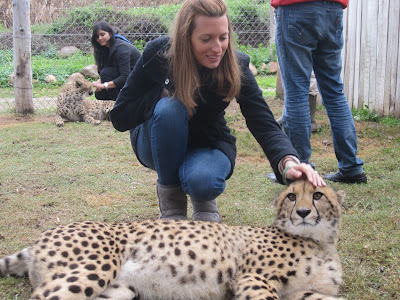



















































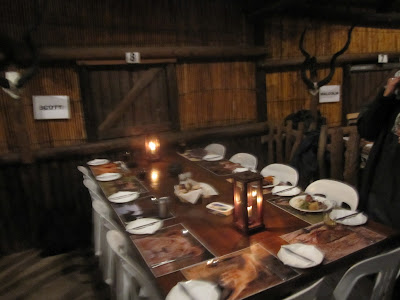






And I must say: you and your dearest Giulia were the best of travel companions that we could have hoped for - seriously - although we were often tired, wet, sandy and dusty (and considering the conditions of some of the smaller roads in Namibia) the spirit was always so very positive and there was NEVER a lack of humour and riling each other when the going got tough. The worst/saddest/most upsetting and emotional part for me was when we had to say goodbye to you in the south of Namibia when it was raining, we could not fix your wipers and you disappeared in the wet an dark yonder heading for Cape Town. We had NO idea what was awaiting you at all ...... but TIA - and you managed so so well!! Tell us when you envisage to see the rest of namibia - we are in!!
ReplyDelete